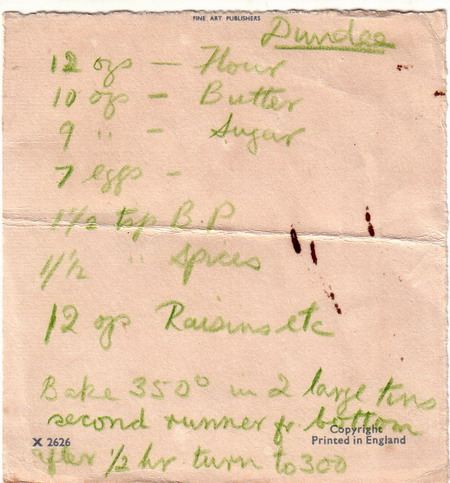A light and crumbly fruitcake, Dundee Cake originated in 19th century Scotland as a commercially mass-produced cake from marmalade company, Keiller’s. Read a wonderfully-detailed account of the history, plus recipe and photo of Dundee Cake here. It’s also typical to decorate the Dundee Cake with concentric circles of split almonds, as you can also see in this photo/recipe. Read a more general history of fruit cake here.
With little more than quantities and a list of ingredients (“Raisins etc.”), Grandmother’s brief notes here assume one is familiar with how a Dundee Cake should taste, the cake-making techniques required to achieve that and perhaps also the conventions of decorating Dundee Cakes. Perhaps many people in the late 50s and 60s would have been well acquainted with Dundee Cakes, as hinted at by this Australian food history blog, which also reproduces the writer’s grandmother’s Dundee Cake recipe from the 1950s :) and says that these cakes were very popular at the time. Incidentally, the blog is by a professional historian of medieval history at the Australian National University!
Even though she was probably never short of anything she needed during her life, my grandmother was always very careful to not be wasteful. She kept drawers full of old receipts and cut-up scraps of paper — held together in neat piles by rubber bands — for scribbling notes on. This recipe, for example, has been scribbled on a tiny scrap of paper, folded and stained by rusty staples, possibly one of the blank end pages ripped out of a book from ‘Fine Art Publishers’, copyrighted and ‘Printed in England’. Grandma also hoarded cupboards full of used plastic bags, all neatly folded into squares, and to save on paper napkins, she would open a packet of them then painstakingly scissor each one into half so that we would only use the minimal amount of paper each time.
From what I hear of others from my grandmother’s generation, these habits of careful use of resources and hoarding things ‘just in case’ weren’t unusual. I’ve wondered whether this was a legacy of living through the hardships of World War II, or whether it was a hangover from days when convenience items such as pads of notepaper and plastic bags were not so cheap (or given away free!) and readily available as they are today. Ironically, the push for greater environmental consciousness is seeing us return to the thrifty ways of our grandparents’ times, or in today’s jargon, ‘ reduce, reuse and recycle’.

Read Full Post »




